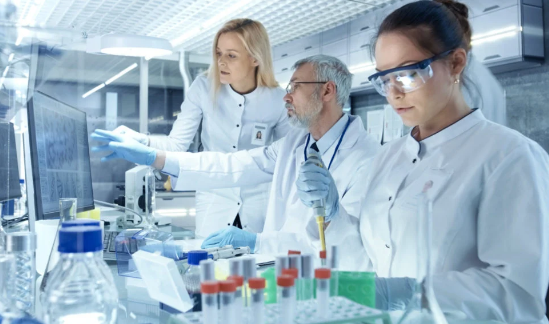A wet lab is a type of laboratory in which a wide range of experiments are performed, for example, titration in chemistry, diffraction of light in physics and characterization of enzymes in biology etc, all of which may sometimes involve dealing with liquid substances. Given that in this type of lab, chemicals and potential wet hazardous products are handled, the rooms have been carefully designed, constructed and controlled to avoid risks such as spillage and contamination. Due to the nature of processes undergone in wet labs, the environmental conditions may need to be carefully considered and controlled using a clean-room system.
Also, in this types of lab, the safety of occupants has been ensured through installation of fire extinguishers, fire alarms, eye washers, showers and vinyl floors. Also the occupants are required to have basic knowledge of laboratory techniques including safety procedures and techniques related to experiments they perform.
A Dry lab is a type of laboratory where computational or applied mathematical analyses are done on computer-generated model to simulate phenomenon in physical realm. The lab is designed specifically to with dry stored materials, electronics or large instruments. The laboratories are just for analytical purposes and may require accurate temperature and humidity control, dust control and clean power. Also have fire suppression systems, communication integration systems and vibration controls for sensitive instruments that need to maintain calibration.
Wet Lab (water based Experiments)

- Wet lab or wet laboratories are laboratories where chemicals, drugs or other biological matter are tested and analyzed using liquids.
- In wet labs, primarily liquids are used in analysis.
- Examples of experiments done in wet labs include: characterizing enzymes in biology, titration in chemistry and diffraction of light in physics.
- Wet labs have materials and finishes that are resistant to bacteria and chemicals.
- The lab is mostly designed with Biosafety cabinets, specialized refrigerators and freezers.
- In wet labs, there are different equipments and facilities with varied functions.
- Because of the nature of the work and the handling of liquids, wet labs require benches, sinks, hoods safety equipments, direct ventilation and piping are a major consideration.
- Most experiments that occur in wet labs have routine procedures and adjust to an identical pattern.
Dry lab (Computer Assisted Lab)

- Dry lab or dry laboratories are where computational or applied mathematical analyses are done with assistance of computer generated models.
- In dry labs primarily electronic equipments such as computers are used in analyzing and evaluation of bio-data.
- Examples of computer assisted experiments include: quantum state analysis, ground theory methodology, and coding and text interpretation, mapping or networking.
- Dry labs have clean power systems for sensitive computers, research instruments and network communication.
- The labs are normally designed with HVAC controls to support cooling and humidity levels.
- In dry labs computers are used to carry out analysis, modeling and simulations.
- Because of nature of work, an effective integrated communication system is usually a major consideration.
- Most dry lab experiments occur inside the online mode and some offline.
Also Read: Difference Between Moist Heat And Dry Heat Sterilization
Differences Between Wet Lab And Dry Lab In Tabular Form
| Basis of Comparison | Wet Lab | Dry Lab |
| Definition | Wet lab or wet laboratories are laboratories where chemicals, drugs or other biological matter are tested and analyzed using liquids. | Dry lab or dry laboratories are where computational or applied mathematical analyses are done with assistance of computer generated models. |
| Analysis | Primarily liquids are used in analysis. | Primarily electronic equipments such as computers are used in analyzing and evaluation of bio-data. |
| Examples of Experiments | Examples of experiments done in wet labs include: characterizing enzymes in biology, titration in chemistry and diffraction of light in physics. | Examples of computer assisted experiments done in dry labs include: quantum state analysis, ground theory methodology, and coding and text interpretation, mapping or networking. |
| Inside Lab Materials | Have materials and finishes that are resistant to bacteria and chemicals. | Have clean power systems for sensitive computers, research instruments and network communication. |
| Lab Design | The lab is mostly designed with Biosafety cabinets, specialized refrigerators and freezers. | The labs are normally designed with HVAC controls to support cooling and humidity levels. |
| Equipments | There are different equipments and facilities with varied functions. | Computers are used to carry out analysis, modeling and simulations. |
| Major Consideration | Because of the nature of the work and the handling of liquids, wet labs require benches, sinks, hoods safety equipments, direct ventilation and piping are a major consideration. | Because of nature of work, an effective integrated communication system is usually a major consideration. |
| Experiments | Most experiments that occur in wet labs have routine procedures and adjust to an identical pattern. | Most dry lab experiments occur inside the online or offline mode. |
Summary
Wet labs or wet laboratories are laboratories where chemicals, drugs or other biological matter are tested and analyzed using liquids. On the other hand, Dry labs or dry laboratories are where computational or applied mathematical analyses are done with assistance of computer generated models.
